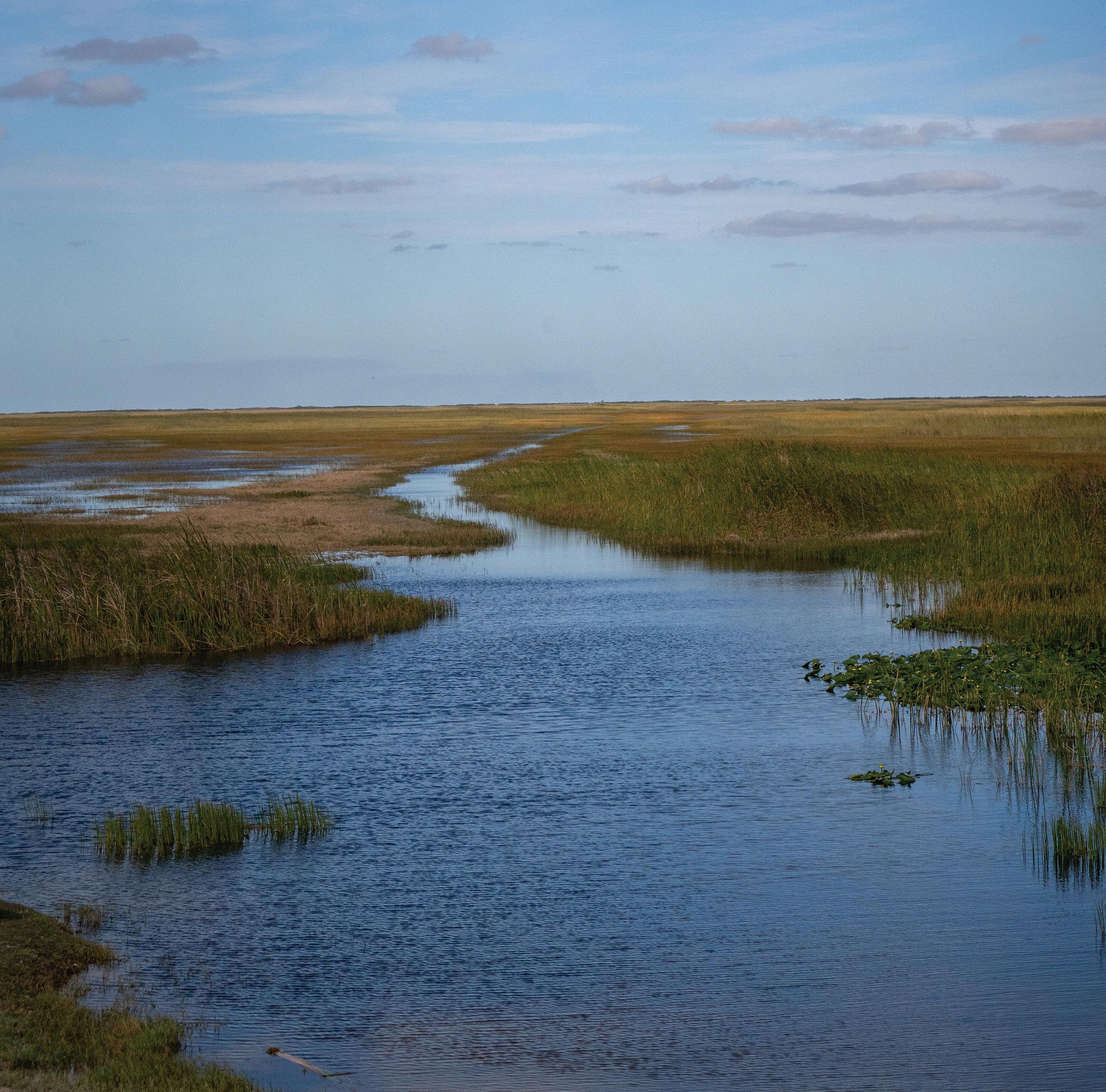

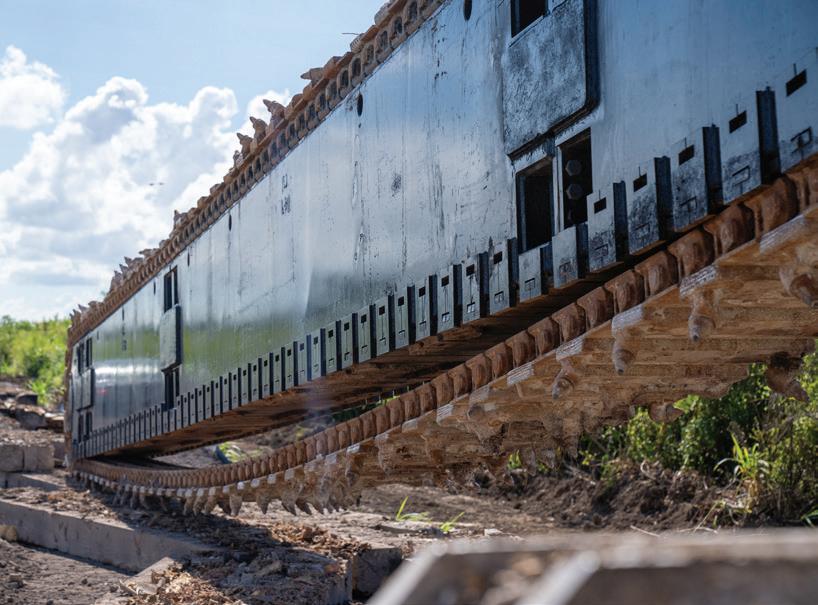
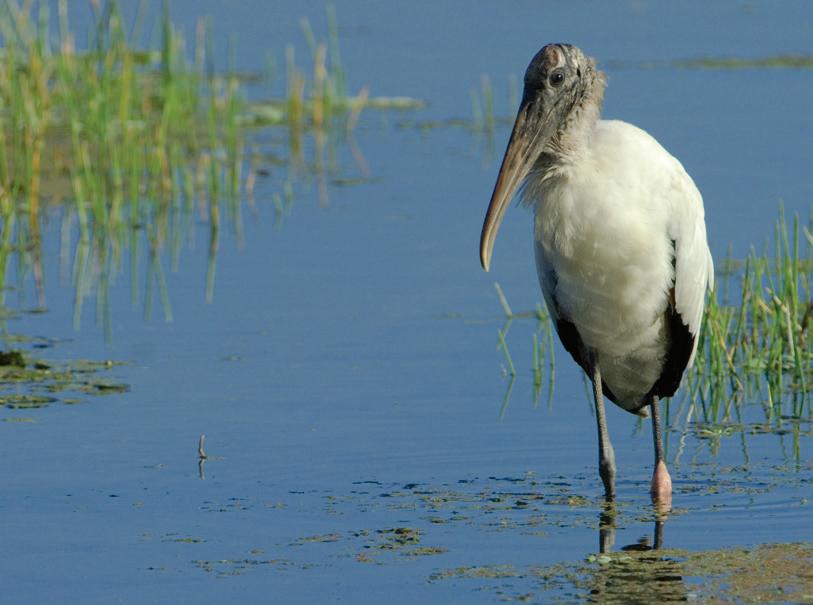
resources
and
2023-2028 STRATEGIC PLAN RESTORATION OF WATER RESOURCES AND ECOSYSTEMS FLOOD PROTECTION WATER SUPPLY PUBLIC ENGAGEMENT AND ADMINISTRATION
This document provides the South Florida Water Management District and the public it serves with a blueprint to successfully achieve balanced regional water resource management for the next five years and beyond. Agency resources are focused on the agency’s core mission to safeguard and restore South Florida’s water
and ecosystems while protecting communities from flooding and meeting the region’s present and future water supply needs. The commitments
strategies in this document will be put into action in order to make a positive and meaningful difference in South Florida.
Headquartered in West Palm Beach, the South Florida Water Management District (SFWMD or the District) is a regional governmental agency that oversees the water resources in 16 counties – from Orlando to the Florida Keys. With a population of 9 million, this region covers 17,930 square miles (31 percent of the entire state) and includes vast areas of urban development, agricultural lands and conservation areas.
Operating for over 70 years, the SFWMD is the oldest and largest of the state’s five water management districts. State legislation further divides the District into two taxing basins: The Big Cypress Basin includes all of Collier County and a portion of mainland Monroe County; the larger Okeechobee Basin comprises the remaining area within SFWMD boundaries.
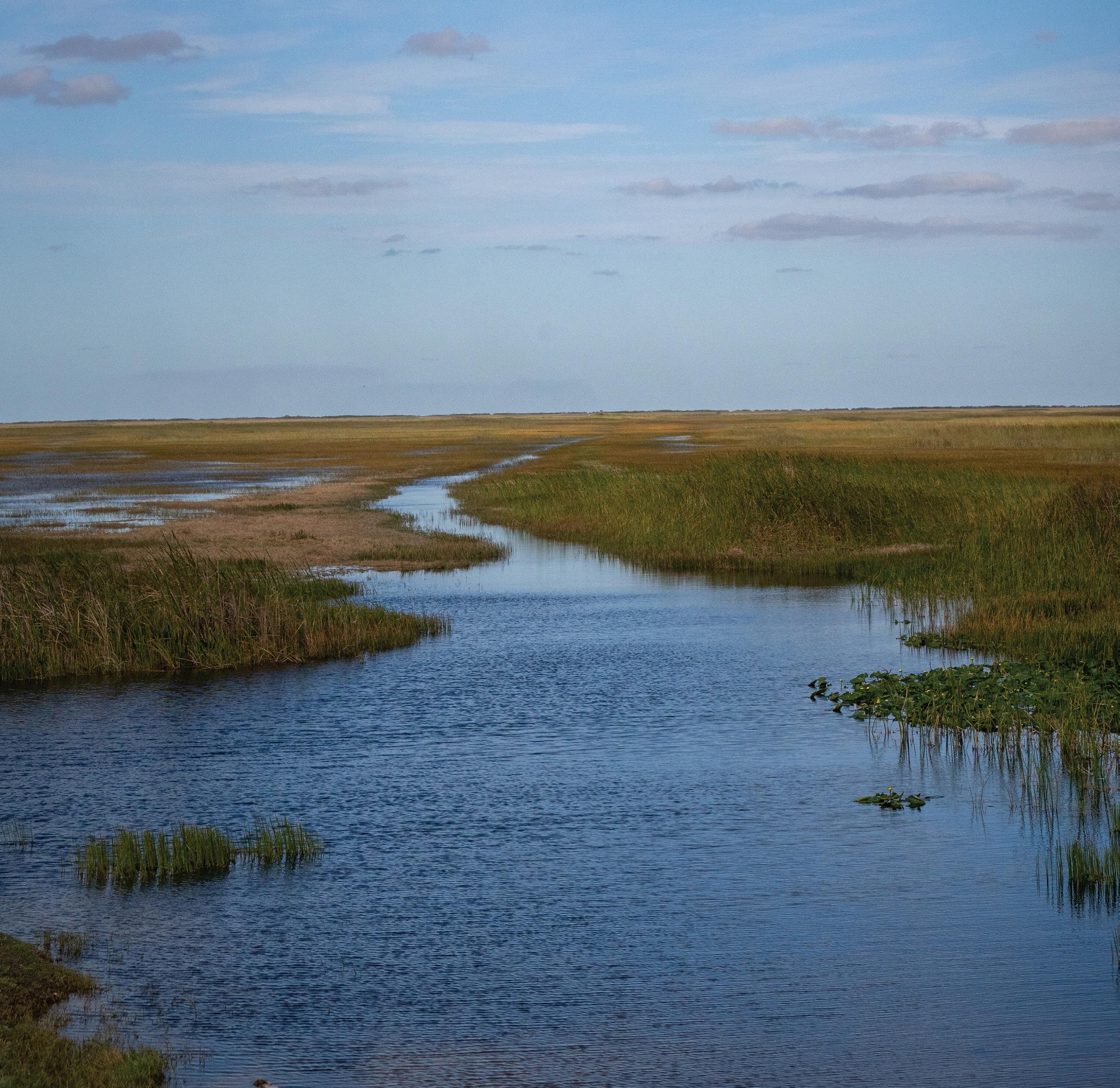
A nine-member Governing Board sets the mission and provides overall direction for the entire District. Board members are appointed by the Governor, confirmed by the Florida Senate and generally serve four-year terms. The annual budget is funded by a combination of property taxes and other sources such as federal, state and local revenue, licenses, permit fees, grants, agricultural taxes, investment income and reserve balances.
The SFWMD is charged with safeguarding the region’s water resources for today and for the future. This includes protecting water supplies and supporting water quality improvements in close collaboration with the Florida Department of Environmental Protection. The agency also operates and maintains the Central and Southern Florida Project, one of the world’s largest water management systems. It is made up of an extensive network of canals, levees, water storage areas, pump stations and other water control structures. The highly engineered system was built through one of the most diverse ecosystems in the world: the interconnected Greater Everglades Ecosystem, which the SFWMD is helping protect and restore.
South Florida itself encompasses a mosaic of diversity from landscapes and habitats to people and cultures. The District strives to ensure that the public is informed and engaged, and that both local and regional perspectives are considered and incorporated into decisions and actions.
In addition to the main office in West Palm Beach, three Regulatory Service Centers and eight Field Stations provide assistance and operational support on water managementrelated issues. The Big Cypress Basin office in Naples provides intergovernmental and project support in the region.
AGENCY OVERVIEW OUR MISSION To SAFEGUARD and RESTORE South Florida’s water resources and ecosystems, PROTECT our communities from flooding, and MEET the region’s water needs while CONNECTING with the public and stakeholders. 2
FIELD STATIONS
Big Cypress Basin (Naples) 2660 N. Horseshoe Dr., #101A Fort Myers 2301 McGregor Blvd.

Okeechobee 316 Northwest 5th St. Orlando 1707 Orlando Central Pky., #200
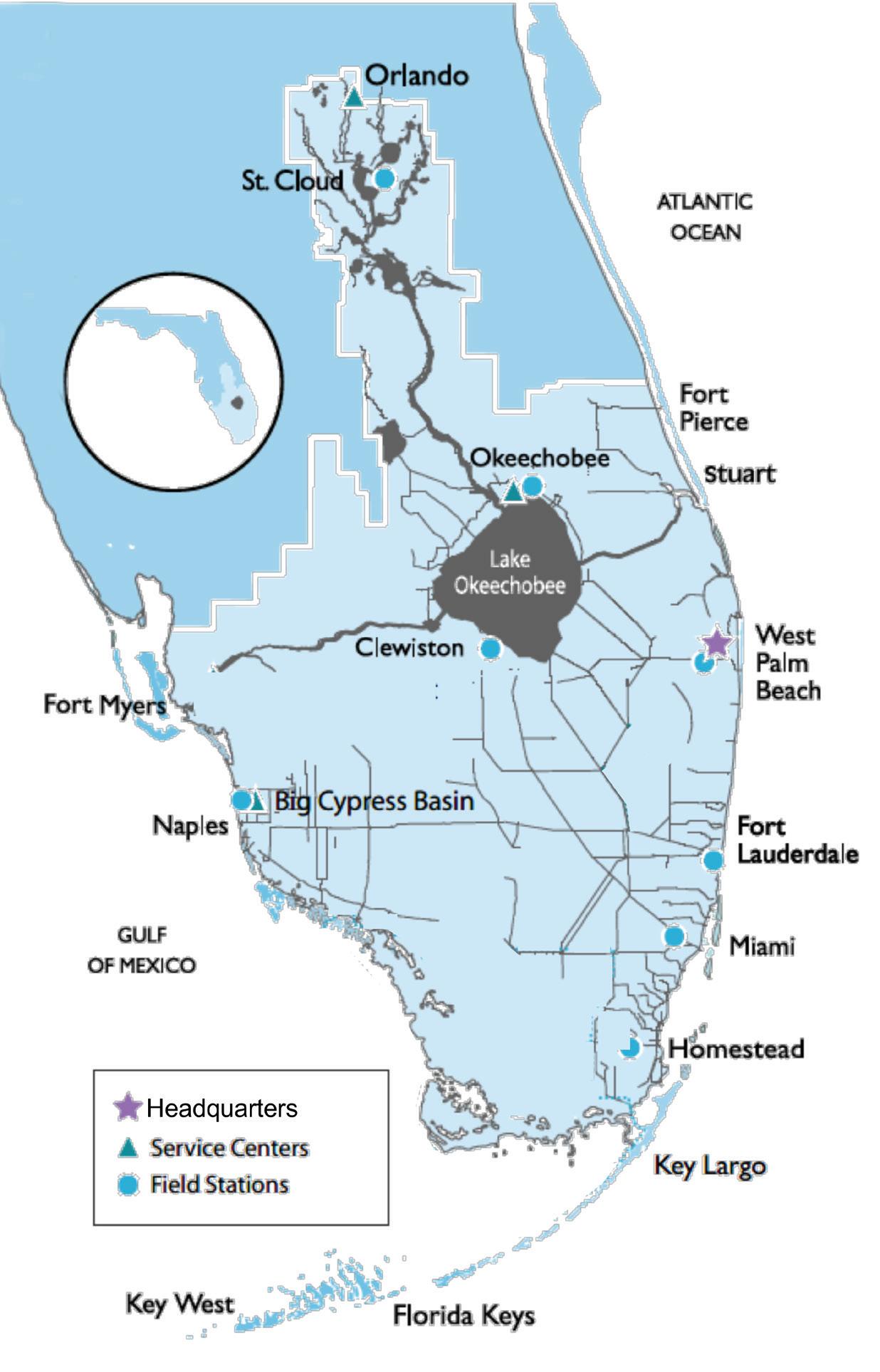
SFWMD LOCATIONS
SERVICE CENTERS
s s s s s s s s s s s s HEADQUARTERS
s
3
Big Cypress Basin (Naples) 3875 City Gate Blvd. N. Clewiston 2425 Hookers Point Rd. Fort Lauderdale 2535 Davie Rd. Homestead 2195 NE 8th S. Miami 9001 NW 58th St. Okeechobee 1000 NE 40th Ave. St. Cloud 3800 Old Canoe Creek Rd. West Palm Beach 801 Sansburys Way
3301 Gun Club Road West Palm Beach, FL 33406
District Headquarters, West Palm Beach
CORE MISSION
RESTORATION OF WATER RESOURCES AND ECOSYSTEMS
Safeguarding and Restoring South Florida’s Delicate Ecosystem
South Florida is characterized by its unique, diverse ecosystems including: the Northern Everglades covering the Kissimmee River, Lake Okeechobee, Caloosahatchee River and St. Lucie River watersheds; and the Southern Everglades encompassing the watersheds south of Lake Okeechobee to the Florida Keys. Over many decades of development, agriculture and increased urbanization significantly changed the hydrology, water quality and ecology of ecosystems throughout the 16-county region. Today, a wide variety of restoration and water quality and quantity improvement projects and programs are underway to protect and restore South Florida’s ecosystem from the Kissimmee River to Florida Bay. Blue green algae and red tide events in the summer of 2018 brought new focus on water resource management in Florida.
Less than 48 hours after taking office in January 2019, Governor Ron DeSantis signed the Achieving More Now For Florida’s Environment (19-12) Executive Order and in July 2020, enacted a comprehensive water bill, implementing additional recommendations from the Blue Green Algae Task Force, state agencies, and the public. Governor DeSantis called for a $2.5 billion investment over four years for the protection of water resources.


Since Gov. DeSantis took office, more than $3 billion in state funds have been allocated for Everglades restoration and the protection of water resources. Most of the District’s Everglades projects are funded by these state appropriations through the support of the Governor and the Florida Legislature. The scheduling and sequence for implementation of CERP, Foundation, and Operational Modification projects is in the Integrated Delivery Schedule (IDS). The IDS provides the sequencing strategy for planning, designing, and constructing projects based on ecosystem needs, benefits, and available funding.
Lake Okeechobee System Operation Manual (LOSOM)
Upper Kissimmee Chain of Lakes Regulation Schedule Restoration Strategies and Clean Water for America’s Everglades
Stormwater Treatment Area 1-West Expansion #2
C-139 Flow Equalization Basin
Stormwater Treatment Area 5/6 Internal Improvements
Northern Everglades and Estuaries Protection Program (NEEPP)
Lakeside Ranch Stormwater Treatment Area (S-191A Pump Station)
Brighton Valley Dispersed Water Management Project
Bluefield Grove Water Farm
Scott Water Farm
Nubbin Slough Stormwater Treatment Area
Caulkins Water Farm
Lake Hicpochee Restoration
Caloosahatchee Reservoir Water Quality Feasibility Study
u
u
u
u
u
u
u
u
u
u
u
u
u
u
u
u
u
u
u
u
u
u
u
u
u
Key Comprehensive Everglades Restoration Plan (CERP) Projects
Everglades Agricultural Area (EAA) Reservoir Project
Caloosahatchee Reservoir
C-44 Reservoir and Stormwater Treatment Area
Lake Okeechobee Watershed Restoration Project
Old Tamiami Trail Roadbed Removal
Indian River Lagoon - South Components
Picayune Strand Restoration Project
Biscayne Bay Coastal Wetlands
Broward County Water Preserve Area
Western Everglades Restoration Plan
Biscayne Bay Southeastern Everglades Ecosystem Restoration Foundation & Other Restoration Projects
Everglades National Park (ENP)/South Dade Hydrologic Improvement (C-111 Detention Areas)
Kissimmee River Restoration
Improve Water Deliveries to ENP - Phase II: Tamiami Trail Road Raising
C-139 Annex Wetland Restoration - Phase II
South Dade Seepage Barrier
Picayune Watershed Water Quality Project Operational Modifications
Herbert Hoover Dike Rehabilitation and Repair
Stormwater Treatment Area 1-East Modification
Bolles Canal Hydrologic Improvement
u
u
u
u
u
u
u
u
4
EAA Project Partnership Signing on April 22, 2021
Completion of the Old Tamiami Trail Roadbed Removal Project
CORE MISSION
RESTORATION OF WATER RESOURCES AND ECOSYSTEMS

Federal, State and Local Partnerships
In partnership with the U.S. Army Corps of Engineers (USACE), the District is implementing the Comprehensive Everglades Restoration Plan (CERP) to improve the quantity, quality, timing, and distribution of water delivered to freshwater and coastal systems in South Florida. The taxpayers have invested $2.5 billion toward the acquisition of more than 253,000 acres required for CERP implementation, project construction and science-based research and monitoring.
The Kissimmee River and floodplain construction is complete through a partnership with the USACE and has produced a functioning mosaic of wetland plant communities. The District acquired 100,000 acres for the restoration effort and conducts on-going scientific evaluations of the ecosystem response. The USACE completed three phases of backfilling the C-38 canal and continuous water flow is now reestablished to 24 miles of the river’s original course.
Gov. Ron DeSantis directed the District to expedite the Everglades Agricultural Area (EAA) Reservoir Project. Construction began ahead of schedule on the Stormwater Treatment Area in April 2020, the state’s portion of the EAA Reservoir Project. The project will provide a significant increase in southern storage to reduce high-volume discharges from Lake Okeechobee to the northern estuaries and deliver increased clean freshwater south. Much of the District’s efforts in the Northern and Southern Everglades are guided by State law in the Northern Everglades and Estuaries Protection Program (NEEPP) Chapter 373.4595, Florida Statutes (F.S.) and the Everglades Forever Act, Chapter 373.4592, Florida Statutes (F.S.) , respectively. These efforts consist of projects, programs, and cooperative initiatives.
An extensive monitoring network is used to measure restoration progress and ensures that SFWMD science staff provides consistent environmental data to decision makers. The District recently expanded the existing monitoring network to transparently provide data on South Florida’s waterways to support projects, programs, and efforts.
In the Northern Everglades, state law directs the coordinating agencies, the Florida Department of Environmental Protection (FDEP), the Florida Department of Agriculture and Consumer Services (FDACS) and the SFWMD, to restore the health of Lake Okeechobee, its watershed, and the St. Lucie and Caloosahatchee River watersheds and estuaries, while continuing to balance flood protection, water supply, navigation and recreational needs. The District supports the coordinating agencies in implementing research, water quality monitoring, and providing technical support in hydrological and ecological evaluation and assessment methods needed to understand how the NEEPP is progressing. The District’s three Watershed Protection Plans provide a comprehensive road map of activities the District will undertake to fulfill its role in the Northern Everglades program areas. Strategies involving one or more of the three coordinating agencies include construction projects; alternative treatment technologies; local water quality projects; public-private partnerships; habitat restoration; and agricultural and urban harmful nutrient reduction programs.
In the Southern Everglades, to achieve compliance with the long-term phosphorus water quality standards established for the Everglades Protection Area, a combination of approaches including stormwater treatment areas (STAs) and programs like agricultural best management practices (BMPs) are in place. In the Everglades Agricultural Area and C 139 Basins, existing programs for implementing BMPs are a part of the
overall strategy. As for the STAs, more than 57,000 acres of constructed marshes and 105,000 acre-feet of storage are now successfully at work improving Everglades water quality.
The State of Florida and the U.S. Environmental Protection Agency reached consensus on supplemental strategies to further improve water quality. This program is referred to as the Restoration Strategies program. The District is implementing a technical plan to complete several projects that will create more than 6,500 acres of new STAs and approximately 120,000 acre-feet of additional water storage through construction of flow equalization basins (FEBs). The strategies also identify funding for additional sub-regional projects to further reduce phosphorus in areas where phosphorus levels are elevated.
Restoration Strategies includes a science plan that targets research and monitoring necessary to improve and optimize the performance of water quality treatment within the facilities. Additional projects south of Lake Okeechobee intended to further assist in managing flow and improving water quality continue to be implemented along with other sub-regional programs and habitat restoration. The District is also working with the USACE during the review of the Lake Okeechobee System Operating Manual (LOSOM) and encourages the public to participate in this process. The District participates in several interagency working groups that seek to achieve ecosystem restoration and stormwater and flood protection improvements. Examples of these groups include Charlotte Harbor Flatwoods Initiative, Loxahatchee River Preservation Initiative and Lehigh Headwaters Initiative. Projects developed by interagency working groups often complement restoration programs such as CERP and NEEPP.
5
CORE MISSION
RESTORATION OF WATER RESOURCES AND ECOSYSTEMS
Expanding Storage Opportunities, Improving Habitats and Cleaning Water
Improved water storage, habitat restoration and water quality treatment in both the northern and southern reaches of the Greater Everglades Ecosystem are key to a healthy environment and strong economy. The natural environment will experience significant benefits as restoration projects come online and begin operating and delivering their desired results. The District is committed to identifying and implementing cost-effective and sustainable solutions to meet the region’s water quality and ecosystem restoration challenges. Specifically, the District will work collaboratively with FDEP and FDACS over the next five years to develop a road map to meet the storage and treatment goals described in the Basin Management Action Plans. The District provides natural resource protection and management while allowing compatible, multiple uses on select public lands in accordance with state law. The District primarily uses the Comprehensive Everglades Restoration Plan’s Integrated Delivery Schedule, Northern Everglades and Estuaries Protection Program, and funding opportunities to identify further restoration projects.
Resiliency and Ecosystem Restoration
Ecosystem Restoration supports the District’s efforts to increase resilience in the face of warmer temperatures, sea level rise and other climate change impacts. The Comprehensive Everglades Restoration Plan’s water storage projects will increase the District’s ability to better manage extreme wet and drought events for the benefit of communities and the environment.
The restoration of beneficial freshwater flows, as the main Everglades Restoration goal, slows down saltwater intrusion, promoting more sustainable aquifer recharge rates, healthier freshwater habitats, estuaries and bays, enhanced water quality, more stable coast lines and reduced marsh dry outs.
Restoration of
Water Resources
and Ecosystems Strategic Priorities and Success Indicators
Mission - Expediting restoration results in the Everglades by:

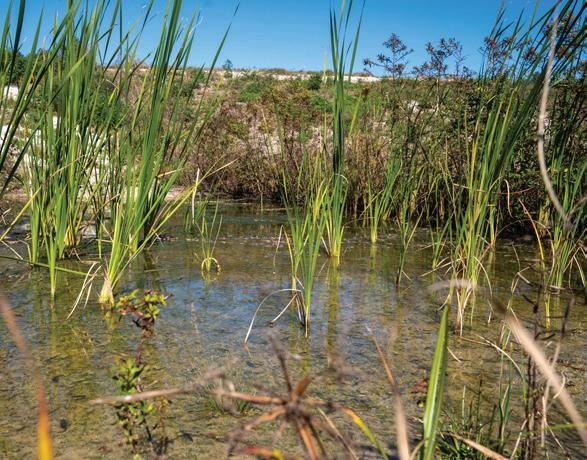
PRIORITY – Advancing the projects identified by Gov. DeSantis
Success Indicators:
u Complete project milestones on time and in budget to advance Key Everglades Restoration Projects identified by Gov. DeSantis
PRIORITY – Maximizing use of available water storage features, such as reservoirs and flow equalization basins (FEBs)
Success Indicators:
u Fully utilize available interim and permanent water storage
u Identify storage needs by watershed to meet flood control, water supply, and environmental goals
u Establish a series of milestones to meet the storage and treatment goals for the Lake Okeechobee watershed
u Meet all Restoration Strategies deadlines and complete associated STA refurbishments by 2024
PRIORITY – Implementing solutions to improve water quality treatment, reduce nutrient loads and reduce the likelihood of harmful algal blooms
Success Indicators:
u Attain ambient water quality standards for phosphorus in the Everglades Protection Area
u Improve water quality entering Lake Okeechobee and the Northern Estuaries
u Meet established Everglades Agricultural Area and C-139 Basin phosphorus reduction requirements
u Continue to encourage preapplication meetings to ensure complete as application submittals incorporating full
implementation of statutorily mandated water quality, water quantity and environmental resource conditions of issuance
u Complete a cumulative summary of Wetland and Natural System Restoration and report annually to each county within the District
u Continue to work with both Public-Public and Public-Private partnerships between state and local agencies, and cost share funding programs to most efficiently leverage funding to support of Picayune watershed.
PRIORITY – Managing invasive exotic and nuisance vegetation and species
Success Indicators:
u Sweep 250,000 acres of District lands for invasive vegetation annually and treat 55,000 acres of invasive vegetation
u Investigate and implement alternative exotic control methods. Reduce herbicide use by a total of 20% between 2020 and the end of 2025
u Remove 1,200 Burmese pythons from Everglades Region annually. Expand adaptive management program to improve python detection and removal rates
u Annually execute prescribed burning on a minimum of 20,000 acres of District conservation lands.
PRIORITY – Increasing access and recreational opportunities on public lands when it does not conflict with ecosystem restoration goals
Success Indicators:
u Provide public recreational opportunities on lands acquired by the District in accordance with state law, maintain a minimum of 80% of all fee-owned lands open for public recreation and provide hunting opportunities where such use is consistent with restoration goals
Stormwater Treatment Area 1E
6
Water Quality Testing
CORE MISSION
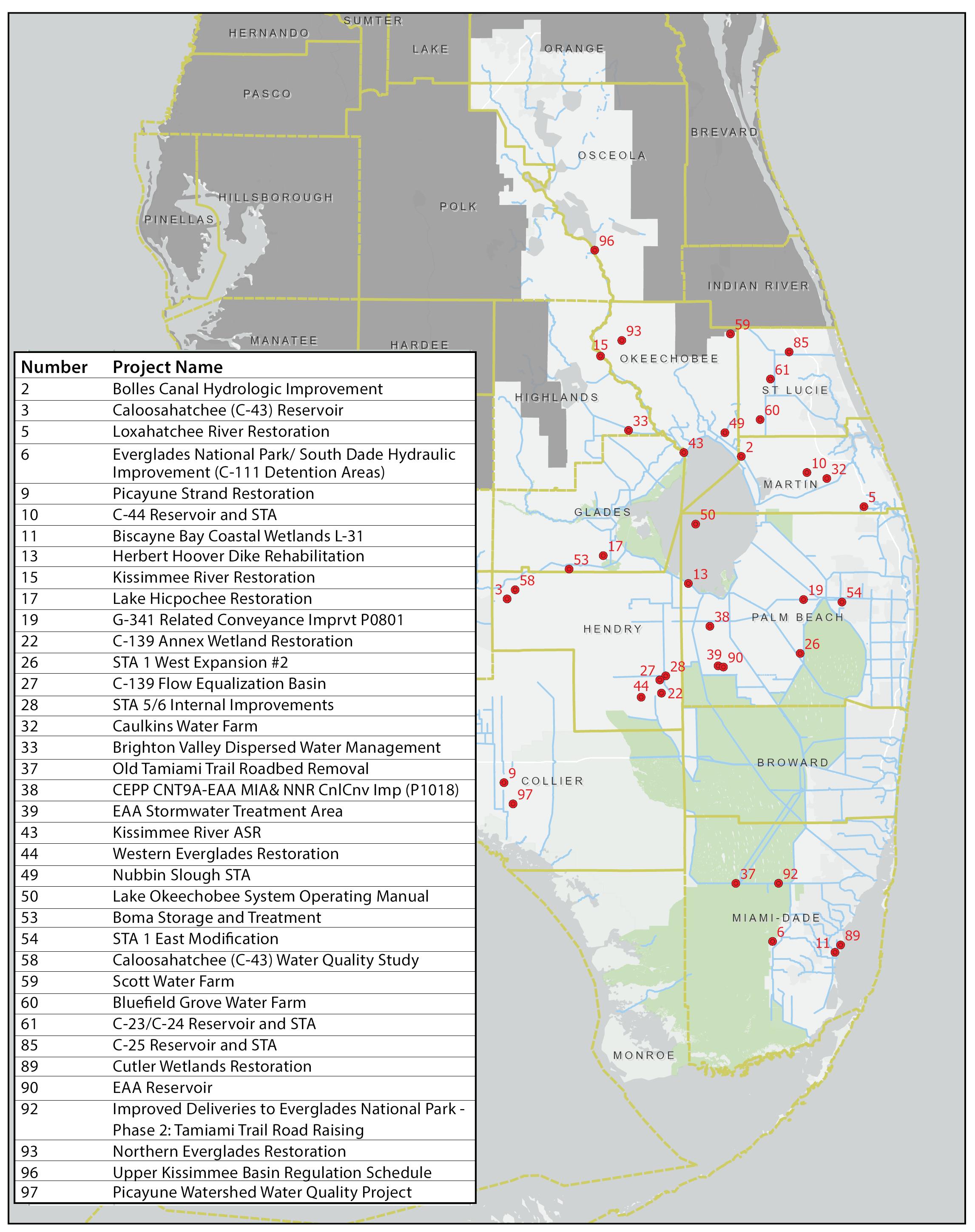
RESTORATION OF WATER RESOURCES AND ECOSYSTEMS
7
Strategic Projects for Safeguarding and Restoring South Florida’s Delicate Ecosystem
CORE MISSION FLOOD PROTECTION
Protecting South Florida’s Communities from Flooding, Ensuring and Managing Water Flow

Tempering South Florida’s weather extremes of flood and drought was the impetus for creation of the agency in 1949. That principal directive continues today through effective operation, maintenance and management of the primary canals, water control structures, pump stations and District-owned public lands, and proper coordination with local governments, water control districts and homeowner and private landowners for the operation of secondary and tertiary systems.
South Florida receives 52 inches of rain fall per year on average, and approximately 75 percent of the region’s annual rainfall typically falls in the six month period from May through October, when intense rainfall is common. Flood protection is a critical responsibility. Rainfall fluctuates annually and conditions move quickly between flooding and drought, and the region is extremely vulnerable to hurricanes and tropical storms. These weather extremes add to the challenges of water resource management. Highly variable rainfall coupled with flat topography necessitates flood protection for the region’s 9 million residents. When the regional Central and Southern Florida Project was designed in the late 1940s, its primary function was flood protection. Since the USACE’s
construction of the public works project from the 1950s to 1970s, the District’s responsibilities as local sponsor of the flood protection system expanded to emphasize various aspects of water resource management. Today, the South Florida Water Management District (SFWMD) operates and maintains more than 2,175 miles of canals, 2,130 miles of levees/ berms, 915 water control structures, 620 project culverts and 89 pump stations. The system is continuously expanding as new restoration projects, such as the Stormwater Treatment Areas, are completed or expanded.
Major flood protection responsibilities include operations, maintenance and refurbishment of system-wide infrastructure, vegetation management, along with hydrological data collection, flow determination and hydrological basin management. Improvements and upgrades to the District’s flood protection system include automation; pump station repair and refurbishment; gravity structure repair and refurbishment; levee inspections and repair; and canal conveyance dredging. Project design efforts continuously consider the integration of green infrastructure into District capital projects.
Kissimmee River Structure Gate S-65D 8
CORE MISSION FLOOD PROTECTION

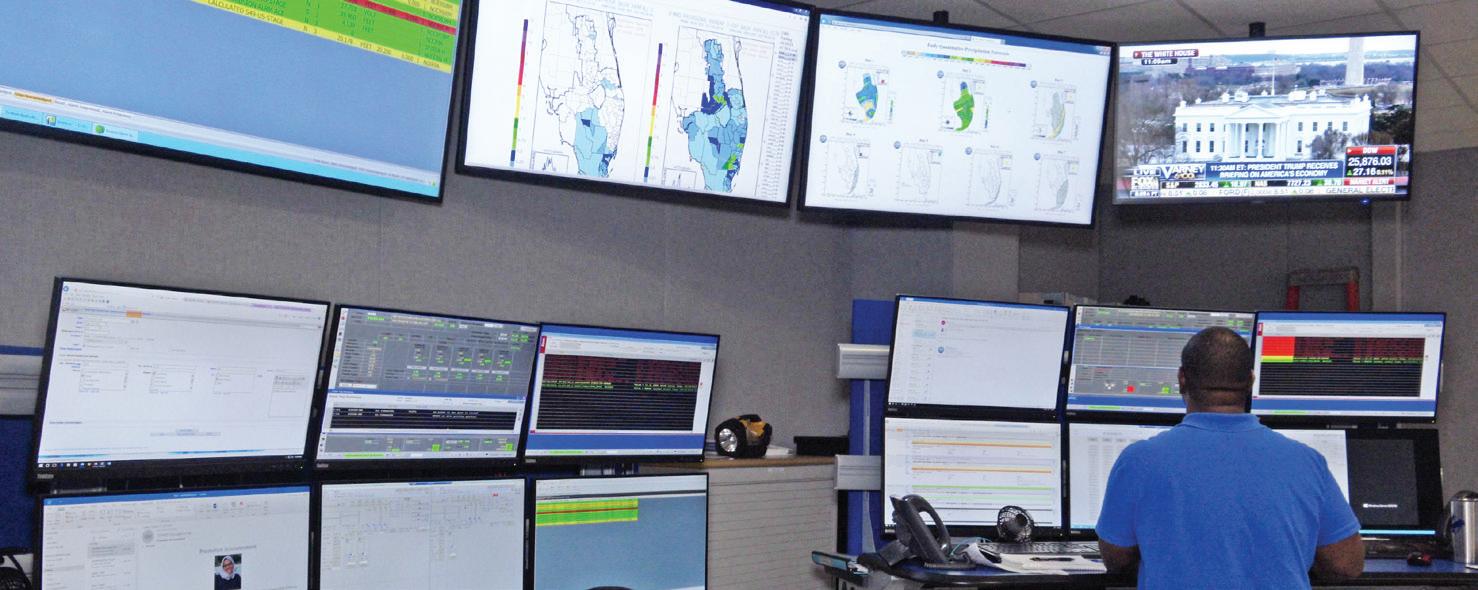
Regional System Expansion and Enhancements
Moving water is central to the District’s mission of flood protection. A well-maintained water management infrastructure assures the public that District facilities are operating at peak efficiency. The District commits to setting aside resources each year to implement the Capital Improvement Plan for repairing, refurbishing, and upgrading pump stations, canals, water control structures, levees, and water storage areas. In addition, construction of new facilities requires an increase in operations and maintenance responsibilities. This includes managing new facilities as well as restoration projects.


District Resiliency Plan
The District is strongly committed to addressing the impacts of climate change, including rising sea levels, changing rainfall and flooding patterns. Current SFWMD resiliency efforts focus on assessing how sea level rise and extreme events happen under current and future climate conditions and how they affect water resource management. The District’s resiliency efforts also focus on understanding the impacts of future climate conditions on ecosystems and restoration efforts. The District is making infrastructure adaptation investments that are needed to successfully implement its mission of safeguarding and restoring water resources and ecosystems, protecting communities from flooding, and ensuring an adequate water supply for people and the environment with special attention to natural and green infrastructure solutions. Resiliency efforts are done in collaboration with the USACE, the State of Florida - through the recently launched Resilient Florida Program under FDEP - and partners in local governments. With a goal to ensure the flood protection system continues to meet the region’s needs into the future, the District is assessing the risk to the flood protection system from development, the impacts of a changing climate, sea level rise, and storm surge. The results of these assessments will support decision making on prioritizing investments and implementing adaptations which will provide long term resiliency and ensure flood protection needs are met into the future.
SFWMD accounts for sea level rise according to available projections advanced by federal agencies, including NOAA and USACE, as well as available regional unified projections, such as the Southeast Florida Regional Climate Compact Unified Sea Level Rise Projections. Beyond sea level rise, SFWMD is also estimating future extreme rainfall conditions and other future climate scenarios, based on the evaluation of existing climate model results in contrast to historic observation data. These observed datasets are being integrated into a set of water and climate resilience metrics to document and communicate trends and shifts in relevant water and climate data, informing the District’s resiliency efforts. A key piece of the District’s resiliency efforts is the Flood Protection Level of Service Program (FPLOS). Under this program, the District studies the canals, structures, and pump stations it operates to ensure that they can provide the level of flood protection they were designed to under future conditions with consideration for sea level rise and other climate impacts. Where the studies identify canals and/or structures, throughout the entire District boundary, that will no longer adequately provide flood protection, improvements are developed to ensure adequate flood protection along with the identification of funding alternatives to support full implementation of the recommended adaptation projects. This strategy ensures a flood protection system resilient to shocks and stresses such as increasingly intense hurricanes, floods, and droughts.
System Maintenance Structure Maintenance Canal Maintenance 9
Water Control Room
CORE MISSION FLOOD PROTECTION
Flood Protection Strategic Priorities and Success Indicators
Mission - Refurbishing, replacing, improving, and managing the components of our water management system by:
PRIORITY – Implementing flood protection infrastructure refurbishment projects
Success Indicators:
u Complete Flood Control Strategic projects on time and on budget
PRIORITY – Incorporating new works into water management system operations
Success Indicators:
u Bring 100 percent of new works online on schedule, prior to project close out
PRIORITY – Assessing and operating the water management system to meet flood protection and water supply needs into the future considering sea level rise and the impacts of a changing climate
Success Indicators:
u Maintain operating water levels within established target ranges to the extent that weather and climatological conditions allow
u Complete FPLOS Assessment Adaptation Studies on time and on budget
PRIORITY – Coordinating with the USACE on infrastructure inspections and results
Success Indicators:
u Achieve passing rating for annual inspection of District infrastructure and provide results to USACE
PRIORITY – Coordinating with state/federal partners and assisting local governments to maintain the level of flood protection
Success Indicators:
u Reduce the average risk rating of District infrastructure through structure inspections and improvements
u Ensure that 90 percent of field station repairs are completed within one year of inspection reports
u Improve communication and coordination with adjacent landowners, including 298 Districts, by developing a process for reducing and litter inputs to District-managed canals and other waterbodies
u Resolve Right of Way unpermitted encroachments
PRIORITY – Optimizing infrastructure maintenance by adhering to, or exceeding, industry standards and best management practices
Success Indicators:
u Perform at least 80 percent of all field maintenance work activities as planned work; no more than 20 percent as unplanned
u Expend no more than 20 percent of field maintenance funds for unplanned work
PRIORITY – Assessing sea level rise and changing weather patterns to determine impacts of future conditions on District mission
Success Indicators:
u Establish key water and climate resilience metrics to document and communicate observed trends and shifts in relevant water and climate data, informing District’s resiliency efforts and modernizing design standards
u Estimate future extreme rainfall conditions and other future climate scenarios, based on the evaluation of climate downsizing datasets in contrast to historic observation data
PRIORITY – Advancing adaption strategies and infrastructure investments, in coordination with local, regional, State and Federal partners, to continue to increase resiliency of its flood protection system and other mission critical services
Success Indicators:
u Enhancement of coastal structures, levees, canals, and other critical flood protection infrastructure to address effects of storm surge and rising sea levels
u Planning and implementing a curtain wall in South Miami-Dade County, to mitigate flooding and support Everglade’s restoration goals
u Partner with USACE in advancing the Central and Southern Florida Flood Resiliency Study to revisit the C&SF Project, with the goal of addressing changed conditions and future climate impacts
u Coordinate restoration, flood protection and water supply efforts to incorporate actions to address climate related impacts and promote resilience adaptation strategies, based on consistent scenario planning and regional modeling approaches
u Communicate, engage, and collaborate with partner agencies, stakeholders, and the public to inform regional and local vulnerability assessments and resilience efforts, and continue to ensure the resilience and safeguarding of the District’s valuable water resources and ecosystems
u Complete District Resiliency Strategic projects on time and on budget, along with the identification of funding alternatives to support full implementation of the recommended adaptation projects
u Complete the annual update of the District’s Sea Level Rise and Flood Resiliency Plan and submit list of projects to FDEP for consideration into the Statewide Flood and Sea Level Resiliency Plan.
10
CORE MISSION
FLOOD CONTROL – DISTRICT RESILIENCY STRATEGIC PROJECTS
Strategic Infrastructure Projects to Address Climate Change and Sea Level Rise

11
CORE MISSION
FLOOD PROTECTION CORE MISSION STRATEGIC PROJECTS
Strategic Projects for Protecting South Florida’s Communities from Flooding, Ensuring and Managing Water Flow

12
CORE MISSION WATER SUPPLY
Ensuring Water for South Florida’s Communities

Water in the State of Florida is a public resource. The District utilizes a variety of tools and technologies to help ensure a reliable and sustainable supply of water for South Florida’s environment, citizens, and community.
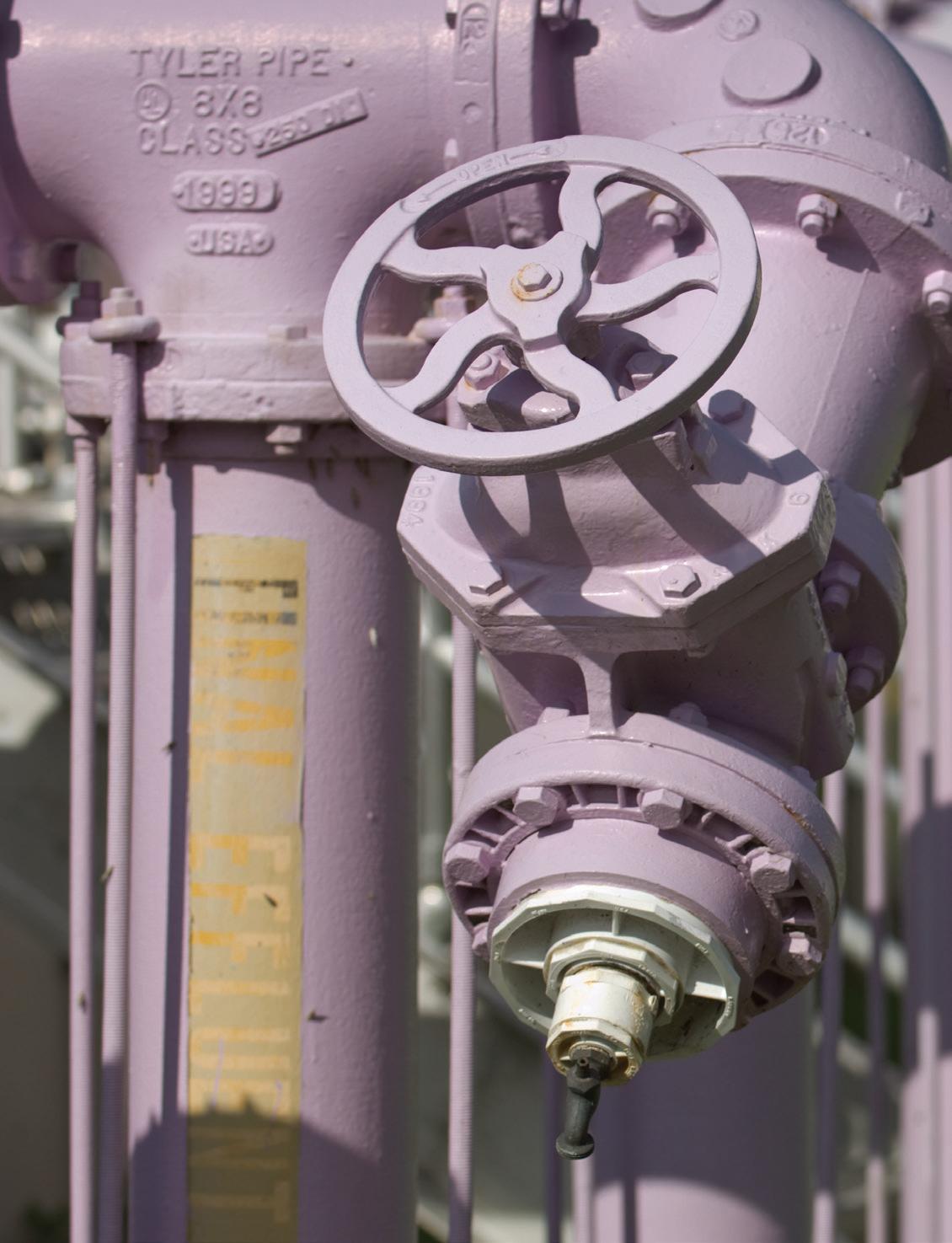
Water supply needs are continually evaluated by the District and appropriate programs are developed to achieve sustainable water resources and related natural systems. Data, computer modeling and analysis are used to evaluate water source conditions for current and projected uses. Increasing development and population have resulted in higher demands for water supply over time and are projected to continue to increase into the future. Planning for a growing water demand must be balanced while ensuring water remains available for natural systems. Changing climate patterns, such as increased rainfall variability, sea level rise, increased evapotranspiration, and warmer air temperatures, may affect water supply demands and sources and need to be taken into consideration in future water supply plans. Freshwater aquifers in coastal counties remain vulnerable to saltwater intrusion. Therefore, coordinated efforts with local governments and other partner agencies are necessary to ensure sustainable water supplies.
To meet Florida’s future water demands, the state’s water management districts are working with water users to best use the state’s traditional water sources while also promoting the development and use of alternative sources. Water supply management strategies include sound planning and permitting; demand reduction through water conservation; development of alternative water sources such as new surface water storage, reclaimed water and desalination of brackish and saline water; and Everglades restoration. Data collection to monitor conditions and increase our knowledge of the water resources is integral to the sustainability of these resources. The District conducts groundwater monitoring, and aquifer system research through installation and testing of new wells.
Resiliency and Water Supply
Part of the District’s strategy to address the impacts of climate change and sea level rise includes analyzing potential impacts that affect water supply sources and the natural system, including enhancing groundwater models to predict potential movement of the saltwater interface. Initiated in 2009, the District monitors and documents the location and movement of the saltwater interface and identifies areas where inland movement of the saltwater interface puts wellfields and other critical resources at risk.
Additionally, sea level rise and climate change adaptations are being considered in the development of water supply plans. This allows the District, local governments, utilities and other water users to plan and proactively implement prevention or adaptation strategies, such as the use of coastal canals and storage alternatives to maintain groundwater levels to slow saltwater intrusion.
13
Water Reuse Purple Pipes
CORE MISSION WATER SUPPLY
Planning, Regulation and Conservation
Water supply plans are updated every five years in collaboration with stakeholders in accordance with the statutory direction provided in Chapter 373, Florida Statutes. The FY2021 Five-Year Water Resources Development Program includes an estimated $1.98 billion of projected expenditures for Fiscal Years 21-25 for water resource development activities and projects. This Work Program is included as Chapter 5A in the 2021 South Florida Environmental Report Volume II.
Based on at least a 20-year outlook, these plans include water demand estimates and projections; an evaluation of regional water resources; identification of water supply-related issues and options; water resource and water supply development components, including funding; and recommendations for meeting projected demands while sustaining water resources and related natural systems.
Alternative water supplies, regional solutions and water conservation are encouraged through strategies that include public outreach/education, policy, voluntary efforts, and financial incentives.
The District regulates and manages the consumptive use of water through consumptive use permits. These permits ensure that proposed uses are reasonable and beneficial, will not interfere with any current
existing legal users and are consistent with the public interest. Rules protect water for Florida’s natural systems and wetlands to preclude harm that could result from water supply over-pumping. In addition, the state’s water reservations authority allows water to be set aside in an ecosystem for the protection of fish and wildlife. Minimum flows and levels are established at specific water resource locations to protect the ecology of those areas from significant harm due to further withdrawals. Associated recovery or prevention strategies are also developed for all minimum flows and levels.
Effective planning and permitting, along with source diversification and water conservation, are key to ensuring that communities are less susceptible to water supply shortages. South Florida’s primary water supply challenges include the need for storage, saltwater intrusion, changing climatic conditions and a growing demand coupled with competing uses.
Finding and implementing cost-effective solutions to resource protection and water supply availability issues require a collaborative approach. Water supply development projects that support the reuse of treated wastewater are included in regional water supply plans, and its beneficial use is encouraged with consideration to improve regional water quality.
Water Supply Strategic Priorities and Success Indicators
Meeting the water needs of the environment and preparing for current and future demands of water users by:
PRIORITY – Developing and implementing regional water supply plans in coordination with local governments, utilities, stakeholders and the public
Success Indicators:
u Approval of five-year water supply plan updates on schedule
u SFWMD water supply plans will identify sufficient water supply sources and future projects to meet existing and future reasonable-beneficial uses during 1-in-10 year drought conditions through 2045 while sustaining water resources and natural systems
PRIORITY – Planning for region’s water resource needs with consideration of climate change and sea level rise challenges
Success Indicators:
u Cumulative percentage of the 2015-2040 increase in public supply demand met by planning region
u Incorporate sea level rise and other climate impacts as a part of advanced integrated water supply planning, with consideration of projected water demands and availability under future conditions
u Maintain and enhance saltwater interface groundwater monitoring network where appropriate; and expand variable density groundwater levels and the extent and rate of inland movement of the saltwater interface, given sea level rise
u Develop a range of sea level rise and other climate scenarios (coastal canal, groundwater level and Everglades Restoration efforts) to evaluate strategies to slow saltwater intrusion
PRIORITY – Encouraging development of alternative water supply projects to diversify water supply
Success Indicators:
u Cooperative Funding Program /Alternative Water Supply & Water Conservation PRIORITY – Promoting water conservation measures
Success Indicators:
u District-wide average annual uniform gross per capita water use (public water supply) is less than 135 gallons per capita daily
PRIORITY – Utilizing regulatory permitting and compliance authority
Success Indicators:
u Continue to encourage preapplication meetings to ensure complete application submittals incorporating full implementation of statutorily mandated consumptive use conditions of issuance
PRIORITY – Using water reservation and minimum flow and level authority to protect water for natural systems
Success Indicators:
u Provide Priority Waterbody List and Schedule for the establishment of Minimum Flows and Levels and Water Reservations annually by November 1
u Complete reservations/minimum flow and minimum water levels analyses on schedule
14
CORE MISSION
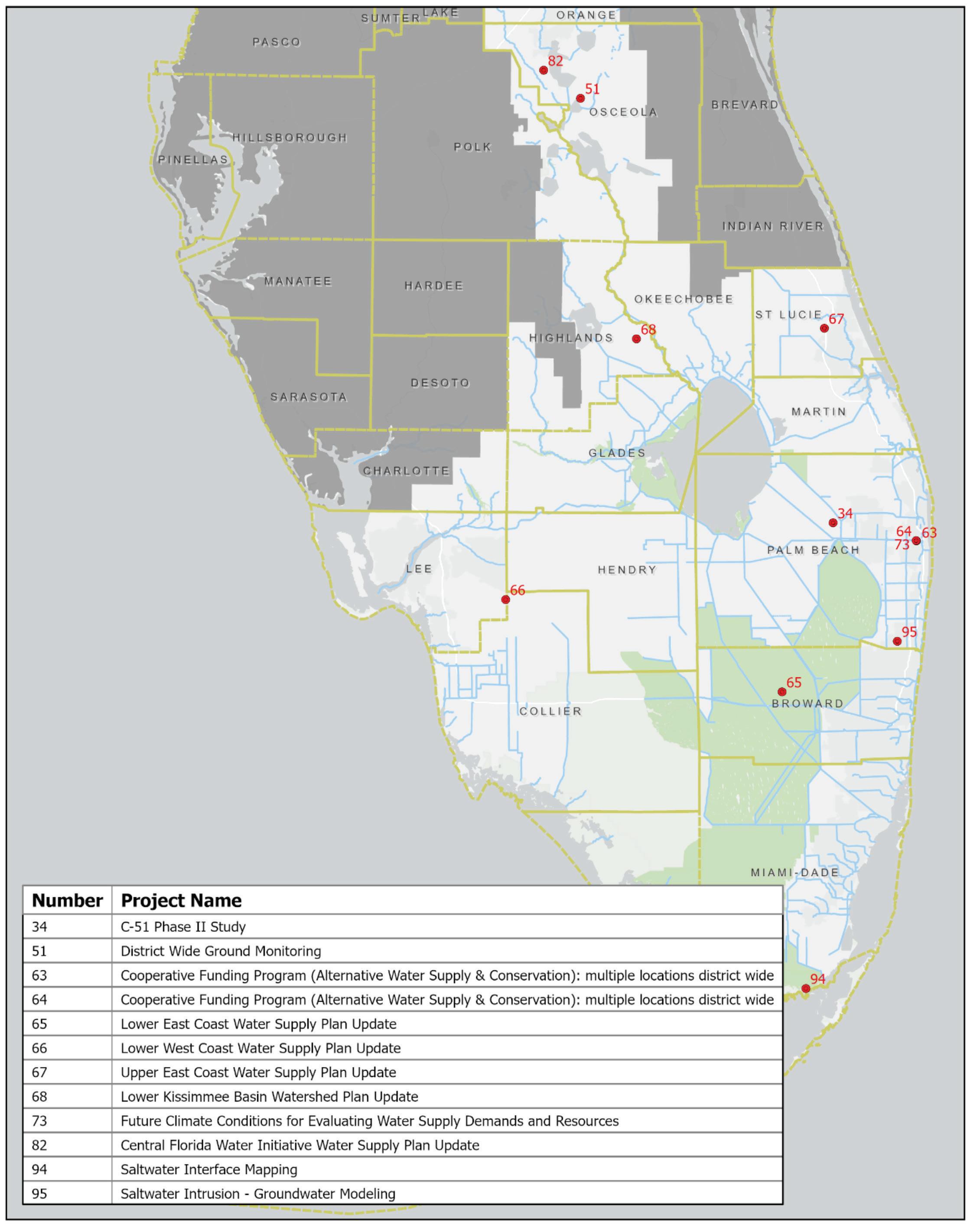
SUPPLY
WATER
STRATEGIC PROJECTS
15
Strategic Projects for Ensuring Water for South Florida’s Communities
SUPPORT MISSION
PUBLIC ENGAGEMENT & ADMINISTRATION
Delivering Efficient and Cost-Effective Services on Behalf of South Florida Citizens
The District constantly looks for opportunities to implement strategies to improve operations, enhance fiscal efficiency, ensure public access and engagement, create more accountability and, most importantly, deliver the services and results that the public expects. Project and operational progress, along with overall organizational efficiency and effectiveness, are continuously measured and reported. Monthly financial statements
are publicly presented at Governing Board meetings and posted online to clearly demonstrate how the District utilizes taxpayer dollars. By routinely collaborating with the public, state and federal agencies, local governments, non-governmental organizations, community organizations and the business community, the District works to further leverage public dollars by identifying additional cost-saving strategies.
Public Engagement & Administration Strategic Priorities and Success Indicators
Ensuring
PRIORITY – Focusing resources on core functions, minimizing administrative costs, and measuring performance
Success Indicators:
u Post monthly financial statements to publicly available website within 24 hours after each Governing Board meeting
u Submit annual audit to the Florida Department of Financial Services and Auditor General within 45 days after Governing Board acceptance but not later than nine months after end of prior fiscal year
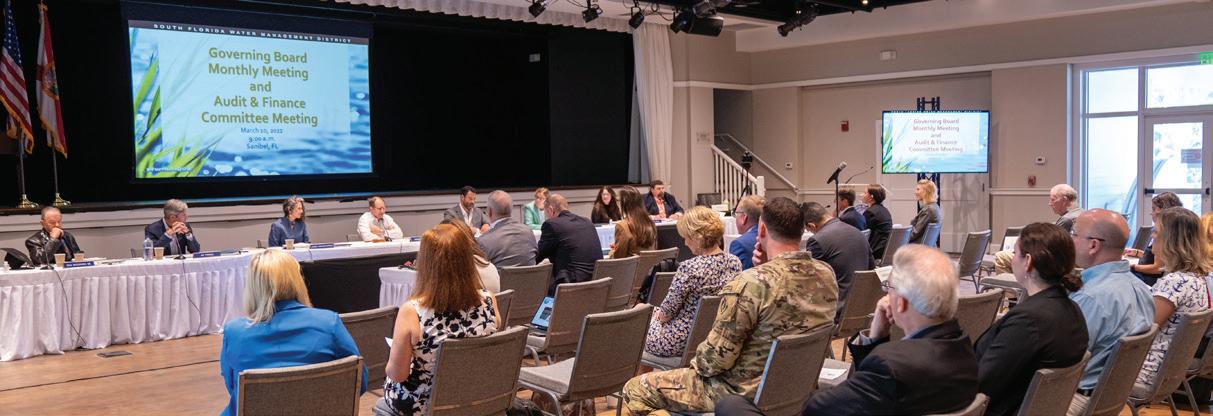
u Complete required distribution of annual audit within 10 days after Governing Board acceptance and ensure posting on the District’s publicly available website within 10 days of acceptance
PRIORITY – Ensuring accountability, transparency, and public involvement in agency decisions
Success Indicators:
u Document, assign and respond to 90 percent of public records requests within 14 days
PRIORITY – Employing and developing a high-quality, diverse workforce
Success Indicators:
u Maintain workforce turnover rate at less than 6 percent
u Ensure more than 90 percent of new hires are retained after the six-month probation period
u Complete quarterly training events via e-learning, classroom and/ or virtually that further develop employee and supervisor skills such as Respect in the Workplace, new supervisor training, and teambuilding
Inventories of Critical Wetlands
In 2022, the Florida Legislature passed legislation requiring water management district governing boards to develop an inventory list of critical wetlands as part of their strategic plans (see Section 373.019(27), F.S.). The South Florida Water Management District is in the process of developing this inventory for inclusion in the 2023-2028 strategic plan. Once available, the listing will be posted to the District’s website at SFWMD.gov/StrategicPlan.
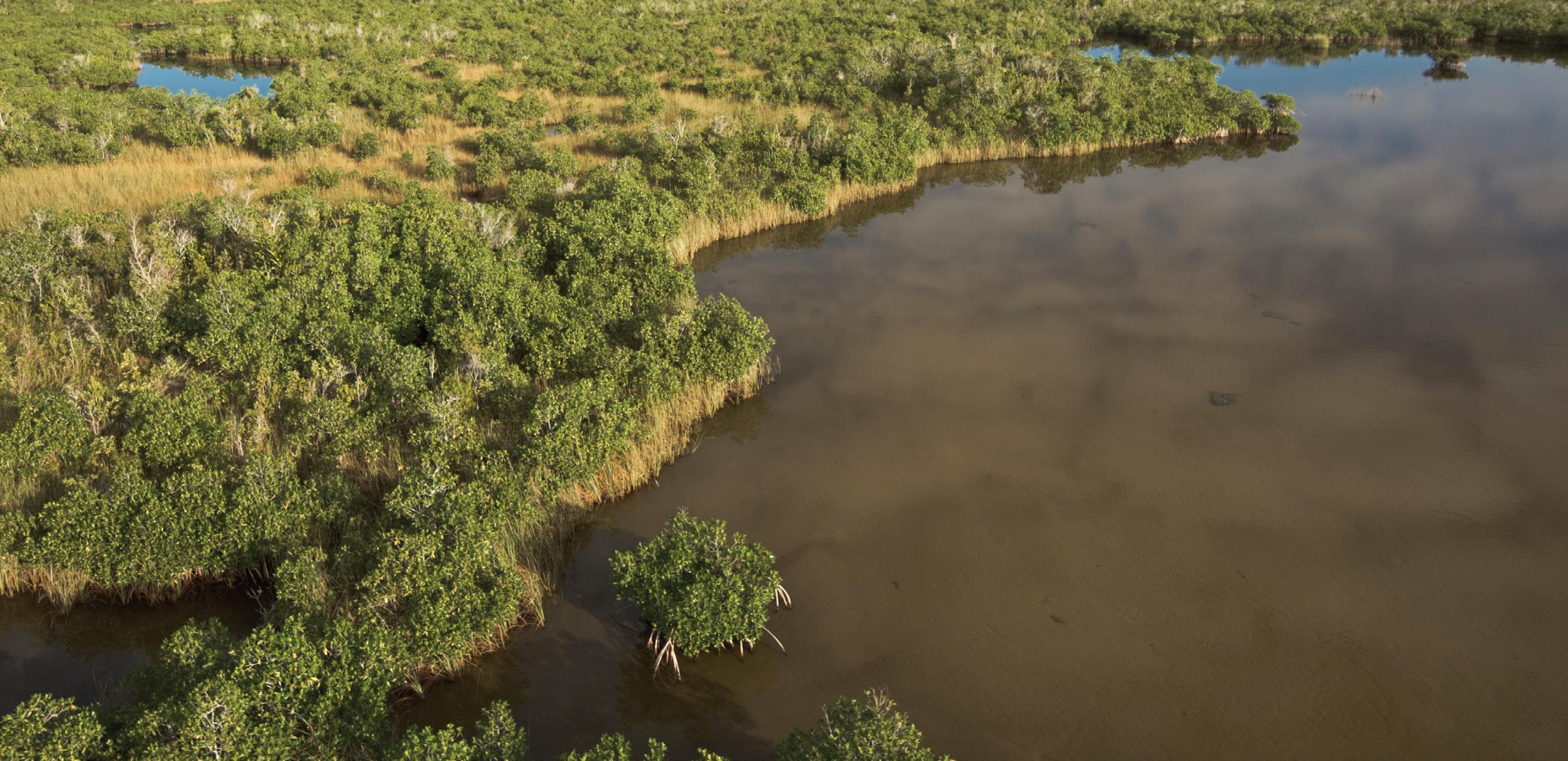
South Florida taxpayers receive efficient and effective customer service by:
16
SFWMD Governing Board Meeting in Sanibel
The Strategic Plan…
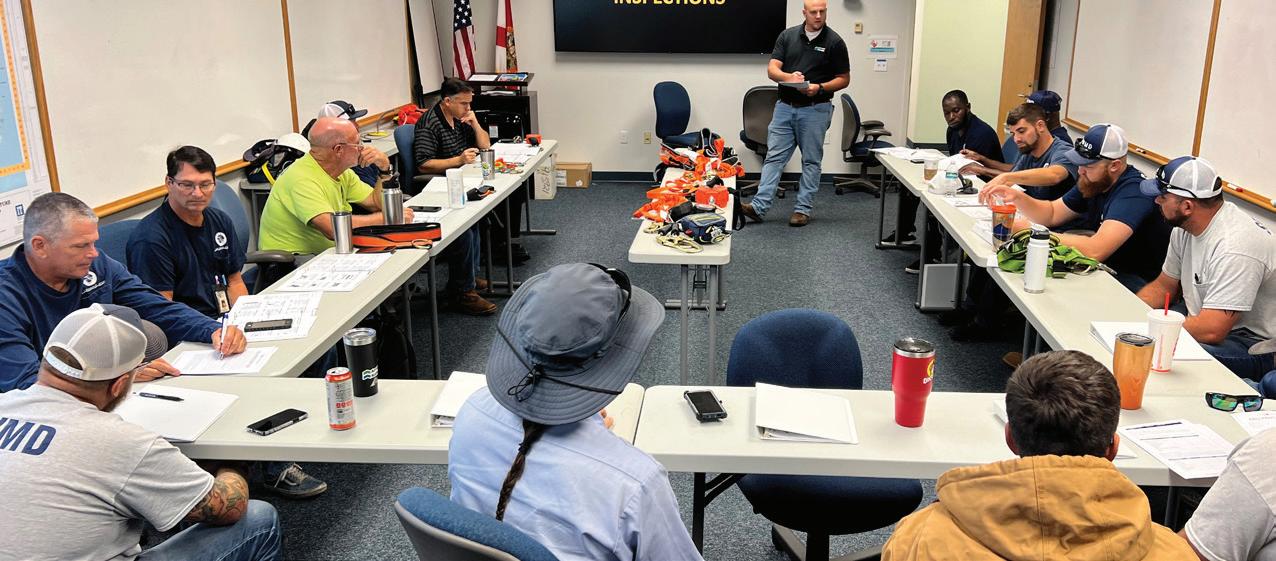
The Strategic Plan is a key component of the South Florida Water Management District’s integrated business cycle. It establishes the overall policy direction and strategic priorities set by the Governing Board to carry out the agency’s core mission responsibilities. Serving as the agency blueprint for long-term planning and implementation, the Strategic Plan provides overarching guidance in development of the annual budget and work plan and the success indicators used for measuring progress.

AGENCY BUSINESS CYCLE PUTTING THE PLAN INTO ACTION Implementing the priorities identified in this Strategic Plan will result in: u Restoration
improvements
water flows and
habitats
refurbished water management system u Achievement
water quality standards u Affordable and reliable water supplies u Public and private partnerships that
stretch limited resources u Efficient and effective customer service
taxpayers u Transparency to the public on
District’s priorities Annual Work Plan Success Indicators: Quarterly, Annual & Water Year Metrics SFER Vol. II Chapter 2 Fiscal Year Performance Accountability Report (Annual Work Performance) Strategic Plan Strategic Priorities • Success Indicators Strategic Plan Annual Budget Annual Work Plan Performance Metrics DISTRICT• PE R F ECNAMRO • EGANAM M ENT•
of the South Florida ecosystem, including
in the timing and quantity of
restored
Regional flood protection provided by a
of
help
for south Florida
the
17



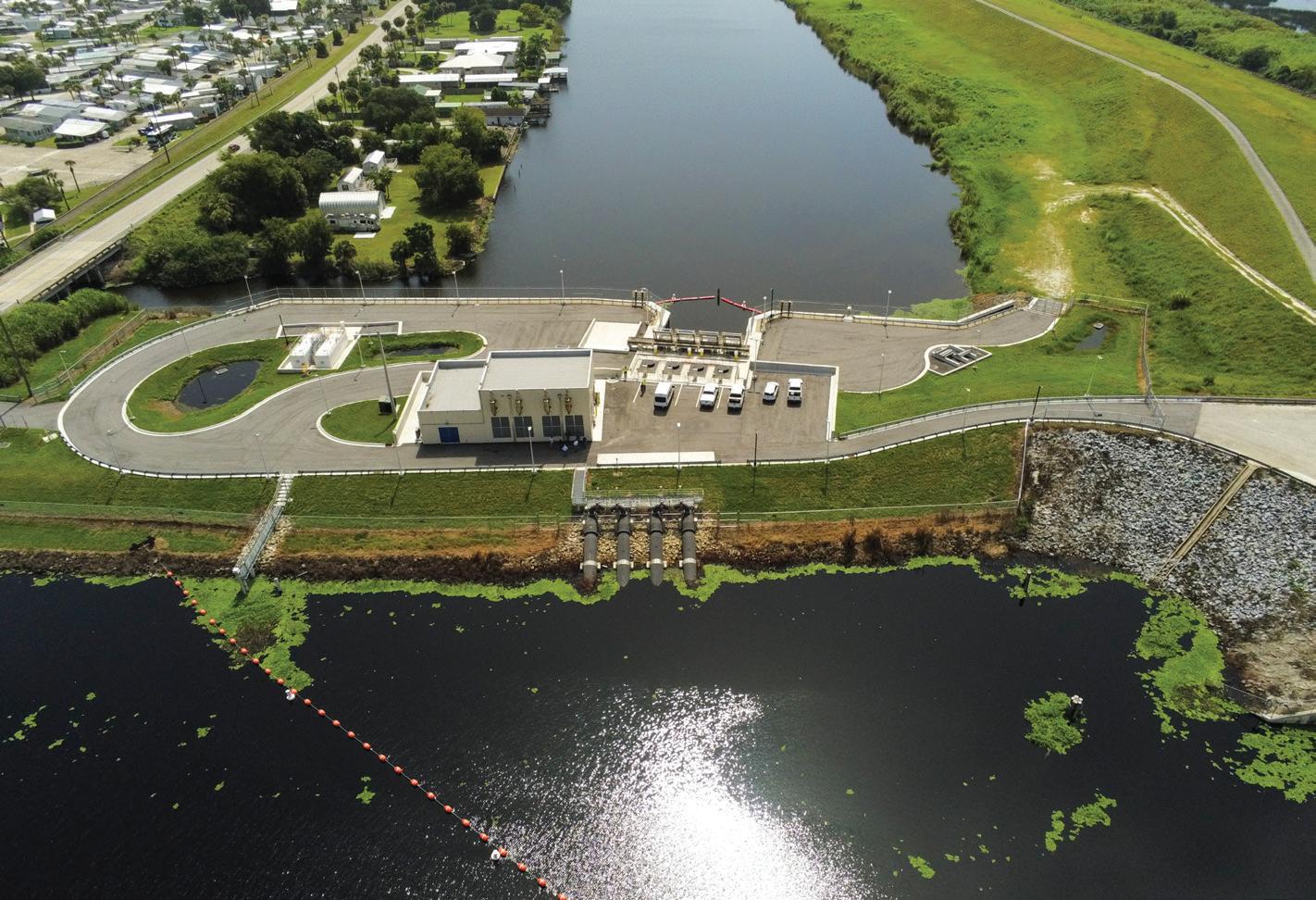
3301 Gun Club Road West Palm Beach, FL 33406 SFWMD.gov Get the latest information from SFWMD Learn more by signing up for the District’s emails. Visit SFWMD.gov and click on “Subscribe for Email Updates.” Connect with us on Facebook, Twitter, Instagram, LinkedIn and YouTube.
Ron
DeSantis, Governor SFWMD Governing Board
Goss, Chairman
Wagner, Vice Chairman Ron Bergeron Sr.
Butler
Chauncey
Scott
Ben
E. Martinez
Charlie
Meads
Cheryl
Roman
Steinle
Thurlow-Lippisch
Charlette
Jay
Jacqui
Hamilton, Secretary,
Department of Environmental Protection SFWMD Executive Management Drew Bartlett, Executive Director John Mitnik, Asst. Executive Director & Chief Engineer Stephen Collins, Real Estate Director Sean Cooley, Communication & Public Engagement Director Jill Creech, Regulation Director Lawrence Glenn, Water Resources Director Candida Heater, Administrative Services Director Lisa Koehler, Big Cypress Basin Administrator Julia Lomonico, Interim General Counsel Dr. Carolina Maran, District Resiliency Officer
Piper, Chief Information Officer
Reynolds, Ecosystem Restoration & Capital Projects Director
Smith, Chief of Staff
Virgil, Field Operations Director
Shawn
Florida
Duane
Jennifer
Jennifer
Rich































